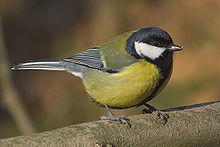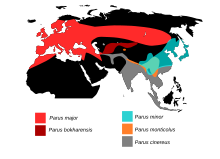Parus is a genus of Old World birds in the tit family. It was formerly a large genus containing most of the 50 odd species in the family Paridae. The genus was split into several resurrected genera following the publication of a detailed molecular phylogenetic analysis in 2013.[1][2] The genus name, Parus, is the Latin word for "tit".
| Parus | |
|---|---|

| |
| Great tit Parus major | |
| Scientific classification | |
| Domain: | Eukaryota |
| Kingdom: | Animalia |
| Phylum: | Chordata |
| Class: | Aves |
| Order: | Passeriformes |
| Family: | Paridae |
| Genus: | Parus Linnaeus, 1758 |
| Type species | |
| Parus major (great tit) Linnaeus, 1758
| |
| Species | |
|
See text | |

| |
| Distribution of the species in the genus Parus. Parus bokharensis is now treated as a subspecies of P. major | |
Taxonomy
editThe genus Parus was introduced in 1758 by the Swedish naturalist Carl Linnaeus in the tenth edition of his Systema Naturae.[3] The genus name is Latin for "tit".[4] Of the 12 species included in the genus by Linnaeus, the type species was designated as the great tit (Parus major) by George Robert Gray in 1840.[5][6]
Species
editThe genus now contains the following species:[2]
| Image | Scientific name | Common Name | Distribution |
|---|---|---|---|
| Parus major | Great tit | Europe | |
| Parus minor | Japanese tit | Japan and the Russian Far East beyond the Amur River, including the Kuril Islands | |
| Parus cinereus | Cinereous tit | West Asia across South Asia and into Southeast Asia. | |
| Parus monticolus | Green-backed tit | Bangladesh, Bhutan, China, India, Laos, Burma, Nepal, Pakistan, Taiwan and Vietnam. |
Fossil record
editReferences
edit- ^ Johansson, U.S.; Ekman, J.; Bowie, R.C.K.; Halvarsson, P.; Ohlson, J.I.; Price, T.D.; Ericson, P.G.P. (2013). "A complete multilocus species phylogeny of the tits and chickadees (Aves: Paridae)". Molecular Phylogenetics and Evolution. 69 (3): 852–860. Bibcode:2013MolPE..69..852J. doi:10.1016/j.ympev.2013.06.019. PMID 23831453.
- ^ a b Gill, Frank; Donsker, David (eds.). "Waxwings and their allies, tits & penduline tits". World Bird List Version 6.1. International Ornithologists' Union. Retrieved 15 February 2016.
- ^ Linnaeus, Carl (1758). Systema Naturae per regna tria naturae, secundum classes, ordines, genera, species, cum characteribus, differentiis, synonymis, locis (in Latin). Vol. 1 (10th ed.). Holmiae (Stockholm): Laurentii Salvii. p. 189.
- ^ Jobling, James A (2010). The Helm Dictionary of Scientific Bird Names. London: Christopher Helm. p. 293. ISBN 978-1-4081-2501-4.
- ^ Gray, George Robert (1840). A List of the Genera of Birds : with an Indication of the Typical Species of Each Genus. London: R. and J.E. Taylor. p. 23.
- ^ Paynter, Raymond A. Jr, ed. (1986). Check-list of Birds of the World. Vol. 12. Cambridge, Massachusetts: Museum of Comparative Zoology. p. 70.
- ^ a b c Kessler, E. 2013. Neogene songbirds (Aves, Passeriformes) from Hungary. – Hantkeniana, Budapest, 2013, 8: 37-149.
Further reading
edit- Gill, Frank B.; Slikas, Beth & Sheldon, Frederick H. (2005): Phylogeny of titmice (Paridae): II. Species relationships based on sequences of the mitochondrial cytochrome-b gene. Auk 122: 121–143. DOI: 10.1642/0004-8038(2005)122[0121:POTPIS]2.0.CO;2 HTML abstract